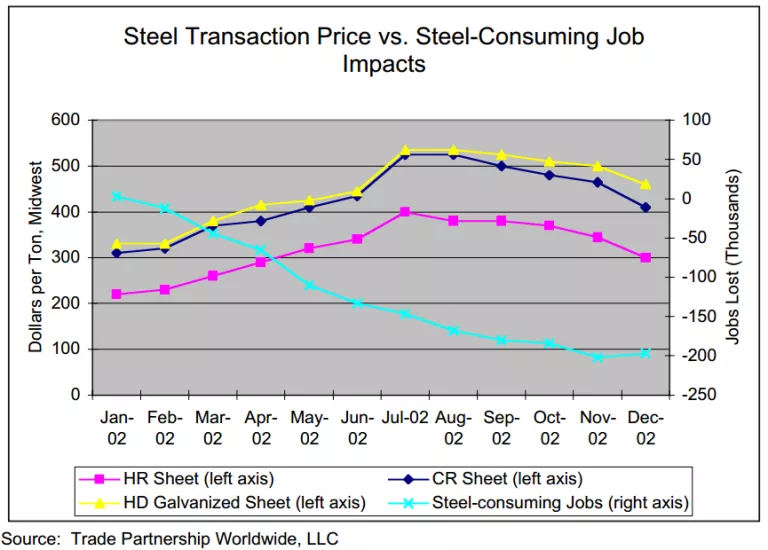- | International Freedom and Trade International Freedom and Trade
- | Expert Commentary Expert Commentary
- |
Ten Things You Need to Know About Tariffs
Tariffs hurt American jobs, benefit special interests, slow economic growth, and more.
1. Tariffs Often Hurt More American Jobs Than They Protect
- Tariffs designed to protect the domestic steel industry may directly affect 140,000 US steel workers, but there are approximately 5.4 million workers in steel-consuming manufacturing sectors who will be hurt by higher steel prices as a result.
- After the import tax on steel in March 2002, steel prices increased, and more people lost their jobs in steel-consuming sectors than in the entire steel industry.

2. Tariffs Hurt the Manufacturing Sector
- The job losses in American manufacturing have overwhelmingly come from increased productivity rather than trade competition.
- Intermediate goods imports account for 43 percent of US imports.
- Because many American manufacturing jobs now rely on imported raw materials, tariffs drive up the cost of manufacturing in the United States. That means tariffs can kill American manufacturing jobs by making it relatively cheaper for companies to produce goods in other countries.
3. Tariffs Are a Punitive Tax on American Consumers
- Tariffs on consumer goods, like washing machines, raise the prices of those goods.
- Like other price increases, tariffs force consumers to spend or save less money. That reduces the amount of money available either to businesses to invest in workers or to banks to lend to growing firms.
- Tire tariffs in 2009 significantly increased costs for Americans buying cars and trucks. American consumers paid approximately $1.1 billion in higher prices. The average cost per job saved was estimated to be nearly $1 million.
4. Tariffs Benefit Special Interests
- Trade barriers have historically been one of the dominant ways in which special interests seek government privilege.
- Current law prevents the International Trade Commission from considering the overall economic effects of proposed tariffs. That means that tariff consideration, by default, values the benefits to specific companies or industries more than the costs imposed on the rest of the economy.
5. Tariffs Hurt Investment
- The Solar Energy Industries Association projects that the 30 percent tariffs on solar panels would cancel billions of dollars in investment, weaken demand, and eliminate 23,000 installation jobs in America.
- One firm immediately cancelled a $20 million investment in a new factory projected to create hundreds of new jobs.
6. Imports Are a Vital Component in America’s Economy
- Exports and imports are 11.9 percent and 14.7 percent of the US economy, respectively, more than double what they were 50 years ago. A big part of that trade is in intermediate goods, which are in-between raw materials and final goods. More than 15 percent of US imports are intermediates.
- Overall, imports contribute 15.3 percent of the value of US exports. Two of our most competitive industries — advanced manufacturing and energy — are among the most reliant on imports.
7. Tariffs Often Result in Retaliation from Trading Partners
- When the United States imposed tariffs on Chinese-made solar panels between 2012 and 2015, China imposed tariffs on polysilicon, which increased the cost of solar equipment and lowered employment for both countries.
- China is reportedly already weighing its options to retaliate against US plans to hike aluminum and steel import tariffs.
- Even the risk of retaliatory trade policy can create uncertainty in an industry, hurting investment and job growth.
8. Trade Deficits Are Not a Justification for Tariffs
- Trade deficit calculations do not include the $4.4 trillion that foreign countries invest in America. When accounting for that investment, the trade deficit closes.
- When people in other countries sell goods to America, they spend the dollars they receive on US exports or assets, or they exchange those dollars with others who will purchase US exports or assets. This means that America’s international accounts are always balanced.
- Moreover, countries with higher tariffs tend to have higher trade deficits.
9. Tariffs Slow Economic Growth
- Average American tariffs fell from almost 60 percent in 1932 to under five percent in 2018.
- The International Monetary Fund has found that these types of reductions in trade barriers can “boost productivity and output,” which can, in turn, mean faster rates of economic growth.
- Economic growth in the late 19th century, while sometimes attributed to high trade barriers, actually resulted from significant population growth and accumulated capital. Tariffs during that time may have hurt growth by raising prices on capital imports.
10. Tariffs Do Not Promote National Security
- Despite foreign competition, the United States is still a major steel producing nation, and the US military has sufficient access to steel to maintain our national defense. National security needs accounted for only three percent of US steel shipments in 2015.
- Because of uncertainty in international trade rules, using a national security justification for a tariff is considered a “nuclear option” that can risk upsetting the entirety of international trade law.
- Tariffs on steel imports are likely to primarily affect industries with no connection to national security interests.